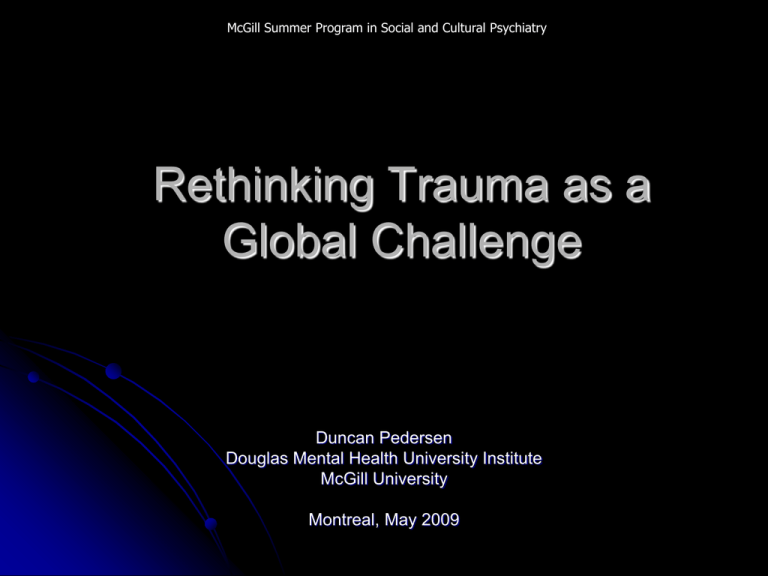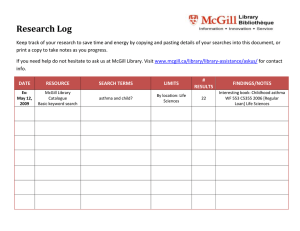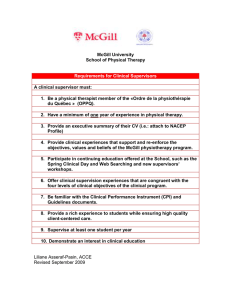Rethinking Trauma as a Global Challenge Duncan Pedersen Douglas Mental Health University Institute
advertisement

McGill Summer Program in Social and Cultural Psychiatry Rethinking Trauma as a Global Challenge Duncan Pedersen Douglas Mental Health University Institute McGill University Montreal, May 2009 www.mcgill.ca/trauma-globalhealth Outline Violence as a public health problem Global violence-related deaths Psychological trauma Trauma and recovery: emerging controversies Complex emergencies Humanitarian interventions Trauma and global health program www.mcgill.ca/trauma-globalhealth Violence is the intentional use of physical force or abuse of power and intimidation, threatened or actual, against oneself, another person, group, community or nation… that either results in or has a high likelihood of resulting in injury, trauma, death, psychological harm, deprivation and long-term disability, or poor development outcomes, and may compromise the health and well-being of individuals, families and communities, affecting the integrity of the social tissue… (WHO, 2002) www.mcgill.ca/trauma-globalhealth •Violence worldwide leading cause of death for people aged 15-44 years. • ...“external causes” rank fourth in worldwide causes of death. • 2/3 non intentional violence (e.g., traffic accidents) - easier to prevent and control • 1/3 intentional violence (suicides, homicides, and organised violence: terrorism, wars and armed conflict, genocide and ethnic cleansing) - difficult to prevent and control www.mcgill.ca/trauma-globalhealth Estimated global violence-related deaths, 2000 Type of violence Number Rate per 100,000 population Proportion of total (%) 520 000 815 000 310 000 8.8 14.5 5.2 31.3 49.1 18.6 Total 1 659 000 28.8 100.0 Low to middleincome countries 1 510 000 32.1 91.1 149 000 14.4 8.9 Homicide Suicide War-related High-income countries Source: WHO Burden of Disease project for 2000, Version 1 www.mcgill.ca/trauma-globalhealth Estimated global homicide and suicide rates (per 100,000) by age group and sex, 2000. Age group (years) Homicide rate Males Suicide rate Females Males Females 0-4 5.8 4.8 0.0 0.0 5-14 2.1 2.0 1.7 2.0 15-29 19.4 4.4 15.6 12.2 30-44 18.7 4.3 21.5 12.4 45-59 14.8 4.5 28.4 12.6 60+ 13.0 4.5 44.9 22.1 Total (age standardized) 13.6 4.0 18.9 10.6 Source: WHO Burden of Disease project for 2000, Version 1 www.mcgill.ca/trauma-globalhealth Traumatic injuries: 4.2 million annual deaths and more than 20 million people with trauma-related sequelae and disabilities caused by violence and diverse external causes are increasing exponentially. Trauma: asymmetric geographical distribution (regional variations) Trauma: asymmetric social distribution Poverty Urbanization Illiteracy Rapid population growth Forced migration and displacement (refugees) Gender Social inequalities www.mcgill.ca/trauma-globalhealth www.mcgill.ca/trauma-globalhealth Trauma: the hidden part of the iceberg - psychological trauma Victims of violence (of intentional origins) are at increased risk of a wide range of psychological and behaviour-related problems: PTSD, depression, alcohol abuse, anxiety, suicidal behaviour, STDs, HIV/AIDS, etc. Natural catastrophes and complex emergencies (of unintentional origins) also have poor mental health outcomes. Today, psychological trauma can be seen as a co-production between various sectors: defence and security, justice, health and social security, education, private sector (pharmaceutical corporations), media, etc. Traumatic events have far broader, more varied and complex meanings and effects than those recognised by conventional nosology and psychiatric practice. These effects evoke a wide range of culturally specific coping and adaptive strategies that are poorly understood. www.mcgill.ca/trauma-globalhealth The social, political and cultural realities structure the context in which violence is collectively experienced and determine to a greater or lesser degree: a) the subjective meaning of violence and traumatic events b) the way in which distress is experienced and reported c) the coping strategies and the type and extent of social support available d) what type of responses (incl. therapies) are available and considered effective and appropriate. www.mcgill.ca/trauma-globalhealth Trauma and recovery: emerging controversies • Consensus: the direct consequences of exposure to traumatic experiences increased disability, morbidity and mortality, including the presence of trauma and PTSD symptoms found in diverse cultural contexts • Emerging controversies and lack of consensus: • • Which are the residual (long-term) effects attributable to sustained exposure to violence? How trauma effects tend to fade away with the passing of time? www.mcgill.ca/trauma-globalhealth Why some people exposed to violence develop PTSD symptoms while others remain apparently healthy? How do the effects of massive trauma exposure (i.e., genocide) differ from a single traumatic episode (i.e., criminal assault)? What are the existing paradigms for helping individuals, families and communities manage and cope with adversity? How can these paradigms be adapted to different social and cultural contexts? How effective are the existing therapies for trauma-related disorders? Lack of consensus or controversy : as to the public health value of the PTSD construct which are the most effective interventions for use in the immediate and the mid term post mass trauma phases. www.mcgill.ca/trauma-globalhealth The term ‘complex emergency’ (CE) is used to describe situations of disrupted livelihoods and threats to life produced by warfare, civil disturbance and large-scale exodus of people, resulting in excess mortality, in which any emergency response has to be conducted in a difficult –often turbulent – political and security environment. civilian populations have become the main target excess mortality as direct or indirect effects of war: >CMR 1/10,000/day (Toole & Waldman, 1990) infectious diseases and malnutrition responsible for a large segment of the excess mortality (Cholera, Shigellosis, TBC, and HIV/AIDS) psychosocial dimension underplayed interventions aim at <CMR with little provision for mental health or psychosocial support www.mcgill.ca/trauma-globalhealth Current responses to massive traumatic experiences: Relief Stabilization Rehabilitation Peace Building Post-conflict reconstruction Development assistance Medical model (psychopathology vs. resilience) (individual vs. collective) Lack of evidence or inadequate evidence on effectiveness of existing therapies for PTSD: 2771 studies 37 RCTs on pharmacotherapy and 52 on psychotherapy (IOM, 2008) www.mcgill.ca/trauma-globalhealth Clinical ambiguity or uncertainty: Dilemma of horizontal vs. vertical (focused) interventions is complete remission an attainable goal? who should (or should not) receive medication? how and why it work in some cases and not in others? mental health remains a low priority untreated mental disorders are high neutral or harmful interventions in management of traumatic stress monovalent vs. multivalent (multisectorial) interventions Lack of evaluation of collective interventions before and after assessment of health outcomes overall quality of life and well being www.mcgill.ca/trauma-globalhealth The new context of humanitarian interventions: an altered epidemiological profile (i.e., complex emergencies) the presence of new actors on the intervention scene (NGOs and the military) a growing demand for closer scrutiny on the quality and performance of humanitarian interventions the recognition of the incompleteness or inadequacy of our knowledge of what should be done when confronted with humanitarian crisis www.mcgill.ca/trauma-globalhealth In conclusion: The interrelations between violence, trauma and collective health are non-linear and more complex than we expected. After 9/11, PTSD adopts a new identity as a phenomena of epidemic proportions, from which new forms of PTSD seem to evolve: virtual PTSD, distanced trauma, tertiary trauma, etc. We need to be cautious looking at the consequences of violence and responses to war and natural disasters through a Western lens… PTSD is not the only health outcome and recovery may not be the result of a simple enterprise. www.mcgill.ca/trauma-globalhealth The cultural contexts where humanitarian interventions are being applied have differing norms, values and traditions, a range of attributions and understandings of causality, different ways of expressing emotions, distress and suffering, and different approaches to help-seeking, healing and coping with traumatic events and adversity. Recovery is practical and unspectacular, and it’s grounded in the resumption of the ordinary rhythms of everyday life – the familial, community, religious, cultural and economic activities that make the world intelligible (Summerfield 2002; Pedersen 2008). www.mcgill.ca/trauma-globalhealth www.mcgill.ca/trauma-globalhealth The Trauma and Global Health program aims to build a sustainable research environment in partnership between the Douglas InstituteMcGill University based in Montreal, Canada, with research teams and their host institutions from four low and middle-income countries: Guatemala, Nepal, Peru, and Sri Lanka, to conduct a global research and action program of advanced studies, continuing education, capacity building and knowledge translation in the social and cultural dimensions of mental health, focussed on the development and assessment of culturally appropriate interventions for the treatment and prevention of trauma-related disorders. The ultimate objective of the program is to reduce the mental health burden of civilian populations exposed to protracted violence and episodic natural disasters, foster the process of healing, psychosocial rehabilitation and recovery, and generate improved mental health policies and services in the participating countries. www.mcgill.ca/trauma-globalhealth

